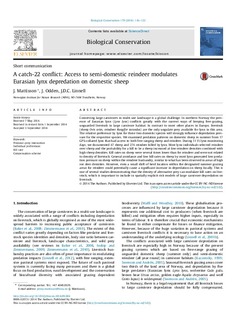| dc.contributor.author | Mattisson, Jenny | |
| dc.contributor.author | Odden, John | |
| dc.contributor.author | Linnell, John Durrus | |
| dc.coverage.spatial | Northern Norway | nb_NO |
| dc.date.accessioned | 2014-10-23T10:36:11Z | |
| dc.date.accessioned | 2018-09-07T11:05:36Z | |
| dc.date.available | 2014-10-23T10:36:11Z | |
| dc.date.available | 2018-09-07T11:05:36Z | |
| dc.date.issued | 2014 | |
| dc.identifier.citation | Biological Conservation 2014, 179:116-122 | nb_NO |
| dc.identifier.issn | 0006-3207 | |
| dc.identifier.uri | http://hdl.handle.net/11250/2561453 | |
| dc.description.abstract | Conserving large carnivores in multi-use landscape is a global challenge. In northern Norway the presence of Eurasian lynx (Lynx lynx) conflicts greatly with the current ways of keeping free-grazing,
unguarded livestock in large carnivore habitat. In contrast to most other places in Europe, livestock
(sheep Ovis aries, reindeer Rangifer tarandus) are the only ungulate prey available for lynx in this area.
The relative preference by lynx for these two domestic species will strongly influence depredation pressure for the respective species. We examined predation patterns on domestic sheep in summer from 17 GPS-collared lynx that had access to both free ranging sheep and reindeer. During 1115 lynx monitoring days, we documented 47 sheep and 274 reindeer killed by lynx. Most lynx individuals selected reindeer over sheep and the probability for a kill to be a sheep increased at low reindeer densities combined With high sheep densities. Kill rates on sheep were several times lower than for reindeer and were not related to density of livestock. General avoidance and low kill rates on sheep by most lynx generated low predation pressure on sheep within the reindeer husbandry, similar to what has been observed in areas of high roe deer densities. However, even a small shift of herd location within the designated summer grazing areas for reindeer could potentially cause a significant increase in depredation on sheep locally. This is one of several studies demonstrating that the density of alternative prey can modulate kill rates on livestock, which is important to include in spatially explicit risk models of large carnivore depredation on livestock. | nb_NO |
| dc.language.iso | eng | nb_NO |
| dc.rights | Attribution-NonCommercial-NoDerivatives 4.0 Internasjonal | * |
| dc.rights.uri | http://creativecommons.org/licenses/by-nc-nd/4.0/deed.no | * |
| dc.subject | Predator–prey interaction | nb_NO |
| dc.subject | Individual preferences | nb_NO |
| dc.subject | Kill rate | nb_NO |
| dc.subject | Compensation scheme | nb_NO |
| dc.title | A catch-22 conflict: Access to semi-domestic reindeer modulatesEurasian lynx depredation on domestic sheep | nb_NO |
| dc.type | Journal article | nb_NO |
| dc.type | Peer reviewed | nb_NO |
| dc.date.updated | 2014-10-23T10:36:12Z | |
| dc.rights.holder | 2014 The Authors. | nb_NO |
| dc.subject.nsi | VDP::Matematikk og Naturvitenskap: 400::Zoologiske og botaniske fag: 480 | nb_NO |
| dc.source.pagenumber | 116-122 | nb_NO |
| dc.source.volume | 179 | nb_NO |
| dc.source.journal | Biological Conservation | nb_NO |
| dc.identifier.doi | 10.1016/j.biocon.2014.09.004 | |
| dc.identifier.cristin | 1166354 | |
| dc.relation.project | Andre: Direktoratet for naturforvaltning | nb_NO |
| dc.relation.project | Norges forskningsråd: 2222222222 | nb_NO |

